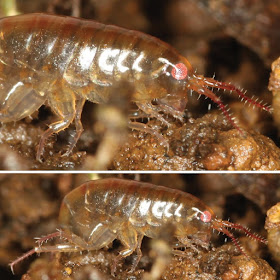 |
| Myanmarorchestia peterjaegeri Hou, 2017 |
Abstract
Myanmarorchestia Hou, gen. n. with two new species is described from terrestrial habitats in Myanmar. This new genus is characterised by 4-dentate lacinia on left mandible, simple gnathopod I in both sexes, weakly chelate gnathopod II in male, simplidactylate pereopods and complex and lobed gills. Myanmarorchestia peterjaegeri Hou, sp. n. closely resembles M. seabri Hou, sp. n. in gnathopod II merus and carpus protuberant on posterior margin; however, the former is distinguished from the latter by palp of maxilla I with two articles, coxal gills convoluted, and telson with nicks on surface. Additionally, DNA barcodes of the new species are obtained to confirm their distinctiveness.
Keywords: taxonomy, Myanmarorchestia, COI, Indo-West Pacific, leaf litter
 |
| Figure 1. Life photo of Myanmarorchestia peterjaegeri Hou, sp. n., one of the female paratypes.
photo:Peter Jäger.
|
Taxonomy
Family Talitridae Rafinesque, 1815
Genus Myanmarorchestia Hou, gen. n.
Type species: Myanmarorchestia peterjaegeri Hou, sp. n.
Etymology: The generic name is derived from “Myanmar” in combination with the Orchestia stem.
Diagnosis: Body size medium. Eyes rounded or sub-rounded, approximately 1/3 of head length. Antenna I reaching mid-point of peduncular article V of antenna II, flagellum a little shorter than peduncle. Antenna II 28% of body length, flagellum a little longer than peduncle. Mandible left lacinia mobilis 4-dentate. Maxilliped palp with four articles, first two articles broad; article III not lobate distomedially, article IV distinct, short, with apical spine and setae.
Gnathopod I coxal plate with anterior process prominent, carpus lacking pellucid lobe, propodus simple, narrowed distally in both sexes. Gnathopod II sexually dimorphic; propodus of male transitional form, weakly chelate, with tumescence, propodus of female mitten-shaped. Pereopods simplidactylate, with two spines at hinge of unguis. Coxal gills present on gnathopod II and pereopods III–VI; each gill lobed and convoluted, one or two lobes with ridged margins or filamentous projections. Oostegites slender, present on gnathopod II and pereopods III–V.
Epimeral plates acuminate posterodistally, ventral margins without armature, lacking submarginal pits. Pleopods well-developed, peduncles with plumose setae on exterior margins. Uropod I peduncle with large distolateral spine, outer ramus marginally bare. Uropod III ramus shorter than peduncle. Telson subtriangular shaped, apically notched, each lobe with one or two apical spines.
Myanmarorchestia peterjaegeri Hou, sp. n.
Etymology: The specific name honours Peter Jäger, the collector of specimens used in this study and an excellent scientist supporting the diversity research in Myanmar; noun (name) in genitive case.
Diagnosis: Eyes sub-rounded (Fig. 1); maxilla I palp with two articles, terminal article very small; gnathopod II merus and carpus protuberant on posterior margin; coxal gills convoluted, with marginal filamentous projections; telson with nicks on surface.
Myanmarorchestia seabri Hou, sp. n.
Etymology: The specific name is derived from abbreviation of the Southeast Asia Biodiversity Research Institute, Chinese Academy of Sciences (CAS-SEABRI); noun in apposition.
Diagnosis: Eyes rounded; maxilla I palp with one article; male gnathopod II merus and carpus protuberant on posterior margin, propodus with tumescence, sub-triangular; coxal gills convoluted; telson bare on surface.
Zhonge Hou and Shuangyan Zhao. 2017. A New Terrestrial Talitrid Genus, Myanmarorchestia, with Two New Species from Myanmar (Crustacea, Amphipoda, Talitridae). ZooKeys. 705; 15-39. DOI: 10.3897/zookeys.705.15045
